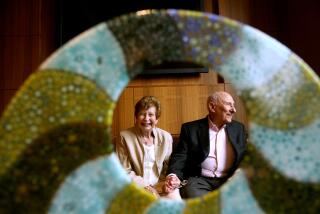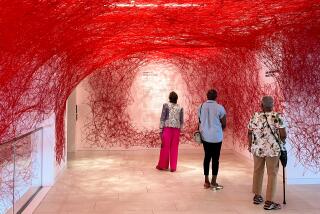Extra credit if you don’t break anything
The only old things in the Getty Villa’s graduate student laboratories are the artworks.
The six students -- one from Turkey, the others from the east and west coasts of the U.S. -- are just embarking on their careers. They are the first to enroll in a new master’s degree program in archeological and ethnographic conservation offered by the Cotsen Institute of Archeology at UCLA and the J. Paul Getty Trust.
After a quarter of classes at the university, they are breaking in pristine labs at the villa equipped with sleek tables, ergonomic chairs, high-intensity gooseneck lights, stereo microscopes and giant mobile hoses that clean the air of toxic fumes. Casually dressed but rigorously focused, the students are examining badly repaired pre-Columbian ceramics from the collection of UCLA’s Fowler Museum.
Working with the museum’s condition reports, published research and their own observations, they investigate materials, techniques and damage, and explore the objects’ origins and functions. Findings are recorded on laptop computers, but some questions cannot be answered with certainty, if at all. The assignment is to learn as much as possible and then propose a method of treatment. In most cases, that will involve taking the object apart and putting it back together after removing unsightly old adhesive.
The fledgling program is the result of the Getty Trust’s effort to fill a gap in the education of art conservators, said program chairman David A. Scott, who headed the Getty Museum Services Research Laboratory from 1987 to 2003, then went to UCLA.
“There wasn’t anything in this part of the world to supply training in archeological and ethnographic conservation,” he said. “People had to go to the East Coast or London.” And those who do don’t find an equivalent course of study. Other U.S. programs (at New York University, Buffalo State College and the University of Delaware) don’t specialize in archeological and ethnographic conservation. The Institute of Archeology at University College London emphasizes the treatment of antiquities but gives relatively little attention to ethnographic material.
Graduates of the UCLA/Getty program will be prepared to work with Native American artifacts, for example, as well as classical antiquities. The three-year program, which admits students every two years, requires two years of course work in classrooms and labs and a year of internship at a museum or archeological site.
The Getty’s partnership with the university was launched in response to “a glaring need for a more academically grounded program,” said Charles Stanish, director of the Cotsen Institute. Intended to provide students with a comprehensive cultural context for their work, the new program “will produce leaders in the field, not just technicians,” he said.
Advanced degree programs in art conservation are few and far between because they are “very labor intensive and cost intensive,” Scott said. The UCLA/Getty program was established with a $2-million endowment from the Getty, to be matched by the university. The Getty provides facilities, equipment, supplies and student stipends. The university supplies the faculty: Scott, assistant professor Ioanna Kakoulli, academic coordinator Ellen J. Pearlstein, staff research associate Vanessa Muros and two program assistants. Getty conservators will give supplementary lectures.
Such programs are also competitive. Admission requirements for the program include a strong academic background in art and science, proficiency in English and another language, practical work in conservation and a portfolio of examples of the applicant’s skill.
“The students have to be dedicated because they know they are not going to earn a fortune,” Scott said. “But there’s no shortage of places for them to go for their internships.” There’s no shortage of work either. “Once the word gets out that we are around, I think the phone may be going off the hook.”
More to Read
The biggest entertainment stories
Get our big stories about Hollywood, film, television, music, arts, culture and more right in your inbox as soon as they publish.
You may occasionally receive promotional content from the Los Angeles Times.










